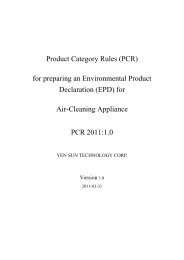Product Category Rules (PCR) - PCR Library
Product Category Rules (PCR) - PCR Library
Product Category Rules (PCR) - PCR Library
You also want an ePaper? Increase the reach of your titles
YUMPU automatically turns print PDFs into web optimized ePapers that Google loves.
Annex E (informative): Assumptions made in creating transport scenario<br />
Assumptions for transport scenario applied to this <strong>PCR</strong> are described in “E.1” to “E.3” below. However, the load<br />
during transport of foamed polystyrene products and food trays is substantially different from that of the other<br />
products according to the trial calculation performed by the industry, the transport scenarios for those two products<br />
were created under different assumptions. They are explained in “E.4” below.<br />
E.1 Transport Distance<br />
a) Domestic transport<br />
For an incentive to provide primary data collection, transport distance is set to a little longer than the average at<br />
possible.<br />
1) Transport within a city or not across adjacent cities: 50km<br />
[Assumption] The distance from a prefectural center to a prefectural border is assumed.<br />
2) Transport within a prefecture: 100km<br />
[Assumption] The distance from a prefectural border to another side of the border is assumed.<br />
3) Transport possibly across prefectural border to another side of the border is assumed: 500km<br />
[Assumption] The distance from Tokyo to Osaka is assumed.<br />
4) Transport from producer to consumer (consumption place is not limited within a specific area): 1,000km<br />
[Assumption] The distance a little longer than half Honshu (the main island of Japan: 1,600km) is assumed.<br />
b) Transport from abroad<br />
1) Transport from production site to “port of country where products were produced”: 500km<br />
[Assumption] The distance from the middle of the state to the state border.<br />
2) Transport from “port of country where products were produced” to port of Japan:<br />
[Assumption] The “reference data” prepared by the CFP Pilot Project Secretariat shall be used.<br />
E.2 Transport Means<br />
a) Domestic transport<br />
Truck transport is basically assumed for an incentive to take CO2 reduction measures in distribution such as modal<br />
shift.<br />
b) Transport from abroad<br />
1) Transport from production site to “port of country where products were produced”: 10-ton truck<br />
2) Transport from “port of country where products were produced” to port of Japan: container ship (4,000TEU or<br />
less)<br />
E.3 Loading ratio of truck<br />
For cases where the loading ratio is unknown, a higher loading ratio (62%) was set for materials having large<br />
physical quantity (weight) relative to their volume such as roll products, and 25% was set for other materials in<br />
general, by referring to the data provided in “Common Guideline ver.3.0 for the calculating method of CO2<br />
emissions in logistics” (Ministry of Economy, Trade and Industry and Ministry of Land, Infrastructure, Transport<br />
and Tourism: March 2007).<br />
E.4 Transport of “foamed polystyrene products” and “food trays”<br />
a) The following transport scenario was created for the transport of foamed polystyrene products according to the<br />
results of the survey conducted by Japan Foam Styrene Industrial Association.<br />
1) Results of the survey<br />
- Scope of survey: Transport data from 21 manufacturers of foamed polystyrene molded products (23<br />
production sites)<br />
- Transport means: 4-ton truck<br />
- Transport distance: Weighted average transport distance; 78.8 km (maximum transport distance; 145km,<br />
minimum transport distance; 17km)<br />
-22-















